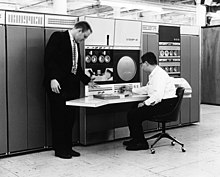 Gordon Bell and Alan Kotok using a PDP-6 in 1964 | |
| Developer | Digital Equipment Corporation |
|---|---|
| Product family | Programmed Data Processor |
| Type | Mainframe computer |
| Release date | 1964 |
| Operating system | early version of what later became TOPS-10, custom versions of the system, ITS, WAITS |
| Platform | DEC 36-bit |
| Mass | 1,300 pounds (590 kg), 1,700 pounds (770 kg) with "Fast Memory" |
| Successor | PDP-10 |
The PDP-6, short for Programmed Data Processor model 6, is a computer developed by Digital Equipment Corporation (DEC) during 1963 and first delivered in the summer of 1964.[1][a] It was an expansion of DEC's existing 18-bit systems to use a 36-bit data word, which was at that time a common word size for large machines like IBM mainframes. The system was constructed using the same germanium individual transistor-based System Module layout as DEC's earlier machines, like the PDP-1 and PDP-4.[2]
The system was designed with real-time computing use in mind, not just batch processing as was typical for most mainframes. Using a 36-bit word with 18-bit addresses allowed it to efficiently store the cons structure found in the Lisp language, which made it particularly useful in artificial intelligence labs like Project MAC at MIT. It was also complex, expensive, and unreliable as a result of its use of so many early-model transistors. Only 23 were sold, at prices ranging from $120,000 to $300,000.
The lasting influence of the PDP-6 was its re-implementation using modern silicon transistors and the newer Flip-Chip module packaging to produce the PDP-10. The instruction sets of the two machines are almost identical. The PDP-10 was less expensive and more reliable, and about 1500 were sold during its lifetime.
- ^ Knight, Tom. "PDP-6 Home Page". MIT CSAIL. Archived from the original on 2 February 2004.
Cite error: There are <ref group=lower-alpha> tags or {{efn}} templates on this page, but the references will not show without a {{reflist|group=lower-alpha}} template or {{notelist}} template (see the help page).